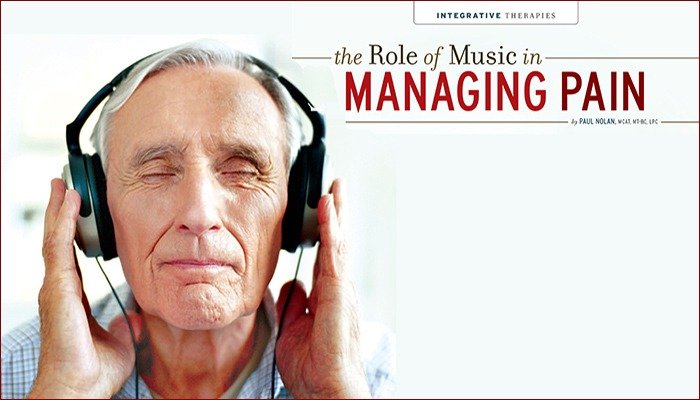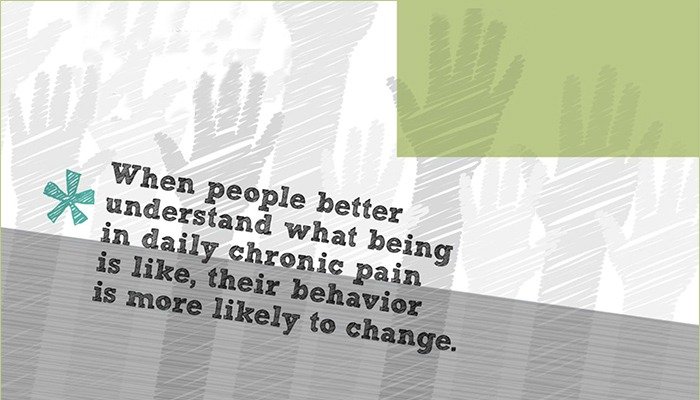Music Therapy

WHAT is it ABOUT music
THAT DRAWS AND FOCUSES OUR ATTENTION, SHIFTS OUR MOODS, RESTORES ENERGY OR LIGHTENS OUR STEP? MUSIC CAN ALSO BRING DISTANT THOUGHTS AND MEMORIES INTO CLEAR VIEW AND, MOST IMPORTANT TO THOSE IN PAIN, CAN DISRUPT THE PAIN EXPERIENCE.
Like other music therapists, I have facilitated and witnessed these beneficial effects in a clinical setting. Each positive effect that a patient experiences is a result of multidimensional physiological and neurological processes that cause psychological and behavioral changes.
The field of music therapy was established in the United States in 1950. Currently, there are approximately 5,000 board-certified music therapists in the United States. Approximately 70 other countries use music therapy as part of their health care system. Music therapy can take place in hospitals, out patient clinics, mental health facilities and educational and correctional settings. Most music therapists are board-certified health care professionals who work a full spectrum ranging from antepartum mother and fetal care through end-of-life and hospice care.
What are some of the mind/brain mechanisms that allow music to alter the pain experience? And how can a person with chronic pain develop personalized uses of music that may facilitate pain reduction?
CLINICAL EXAMPLE
Playing music or listening actively creates the cognitive and emotional conditions that can positively alter the pain experience. Marie was 79 and hospitalized with bone cancer throughout most of her body. She suffered severe pain, was depressed and anxious, and occasionally had suicidal ideation. She found it too difficult to get out of bed to interact with the other patients or take part in activities, so music therapy was suggested.
Right away, Marie was able to listen to me play quiet guitar music. As we developed a positive music therapy relationship, she was able to receive and follow the music with greater concentration. She soon responded with positive emotions, evidenced by the expressive swaying of her arm to the guitar instrumentals. After another music therapy session in her room, she discussed her love for piano music. During our next session we were able to walk from her bed to the piano in the music therapy room and sit side by side on the piano bench. As I played, Marie spoke about having played piano as a child. I suggested that while I improvised she place her hand on the keyboard and find some notes that seemed to fit with my playing. I incorporated her note choices into the improvised music. She was able to focus attention upon this playful task and soon could develop short melodic phrases to include in our improvisation. She seemed to have her eyes closed as she lifted her other arm and allowed it to sway to the music. After a few minutes she rested and stated that the music was beautiful. She reported that during the music therapy session she felt as though she were float-ing, and she forgot about her pain. Talking about the music prolonged her pain-free state.
Marie’s example provides a glimpse into both the method and the science of how music encourages pain suppression. The key psychological responses are:1) the intentional focus on the music, which initially causes a distraction from pain; and 2) the role of positive emotions in leading to a neurochemical analgesic effect.
HOW THE BRAIN USES MUSIC TO REDUCE PAIN
Playing and listening to music involves a robust activation within the brain. There is no one specialized brain center that is responsible for how we hear and produce music. Rather, several brain areas combine their functions and continually communicate with other areas. Depending upon the listening or playing task, different centers of the brain will “light up” during brain imaging studies. For example, if we analyze the way the melody relates to the background rhythms or harmony, we may show more left-hemisphere activation. But if we listen to the same section of the music as a whole and enter into a state of deep relaxation, or in Marie’s case, pleasurable floating, we will show more right-hemisphere activation. Intentional listening — meaning that we really focus on the sounds and their relationship to other musical sounds — can provide a distraction response, while surrendering to the emotions that arise from the music adds to the positive emotional response that can activate pain suppression.
Scientists have known for some time that the pleasure center of our brain — the nucleus accumbens, part of the basal ganglia — becomes activated in response to certain drugs, like cocaine, as well as during sex and other exceptionally pleasurable experiences. Research now reveals that music also activates this region. When the pleasure center is activated it sends signals to other brain areas, including the amygdala and the frontal lobe, to tune out other stimuli and provide more of, or continue with the pleasurable stimuli.
One powerful neurochemical reactions that occurs because of positive emotions is the endorphin release to the neurons in the dorsal horn, a process that closes off the pain signals from the ascending nerve pathways emanating from the spinal cord. This was initially proposed five decades ago as the “gate control” theory, the capacity of the nervous system to transmit only one major sensory signal at a time.
When the nervous system picks up one vitally important or powerful sensory signal, other sensory information is either muted or blocked from ascending into higher brain regions, hence closing the gate to other signals. Pain, as a powerful and important signal, also closes the gate, creating a singular, overriding focus for the person in pain. Positive emotions that are sufficient to release endorphins can close the gate and thereby reduce or stop the pain messages. Music therapists regularly facilitate pain suppression for their patients and clients in inpatient and outpatient settings through eliciting the positive emotions that result from music experiences.
The pain experience includes many factors that contribute to this Gestalt-like whole phenomenon. Pain cognitions can include a sense of purposelessness, a preoccupation with the self, role limitations, depressed and anxious emotions, time distortions, reduced interpersonal interest, physical tension and tissue damage. By increasing positive emotions via intentional music participation, negative emotions such as anxiety and fear are decreased. Anxiety and stress can result in abnormally high levels of cortisol. This response can exacerbate diseases such as cardiovascular disease, gastritis, irritable bowel syndrome, peptic ulcers, diabetes, migraine headaches, asthma and rheumatoid arthritis.
Finally, experiencing emotions — for example, the process of accessing and reflecting upon one’s own emotions — enhances adaptation and reduces the tendency for pain catastrophizing, the tendency to feel helpless and ruminate upon pain sensations.
WANT YOUR OWN PORTABLE MUSIC THERAPIST? THERE’S AN APP FOR THAT.
eMT-CP (empathetic music therapy on chronic pain) is a music therapy app developed by Francisco J. Vico, MD, and a research group at the University of Malaga to help in the self-management of chronic pain. In cooperation with the American Chronic Pain Association they have begun a large-scale ambulatory clinical trial involving thousands of people who will test its efficacy. Music content has been designed by music psychologists, according to recommendations in medical literature, com-posed by a supercomputer and supervised by musicians. Music is played according to the evolution of a listener’s physiological state. Monitoring and feedback are done by a smartphone connected to artificial intelligence algorithms, and music is streamed depending on how the listener feels. For more information or to download the app, go to HTTP://WWW.THEACPA.ORG/MUSIC-APP.
WHAT IS INTENTIONAL MUSIC PARTICIPATION?
Intentional, or active, listening is key to reducing pain through music. The following ideas, used over time and with intentional focus, have been shown to help manage pain.
{1} CHOOSE A LISTENING ENVIRONMENT THAT YOU CAN CONTROL. Have it be as free as possible from an irritating or alarming background or other distractions. Turn off the cell phone.
{2} CREATE A PERCEPTUAL MINDSET, PREPARING YOURSELF TO BE “READY TO RECEIVE.” Place yourself on a comfortable chair or couch and relax your body. Closing your eyes may be helpful.
{3} PLAY MUSIC YOU PREFER, NOT SOMEONE ELSE’S MUSIC “PRESCRIPTION.” Remain open to experimenting with different types of music.
{4} BE OPEN TO THE IDEA THAT MUSIC CAN HELP. Believe that the experience of moving toward beauty can, with practice and patience, transcend your current state and lead toward something better.
STEP BY STEP: USING MUSIC TO TRANSCEND PAIN
Get started by selecting an instrumental arrangement that you find soothing, one that lasts from five to eight minutes. You can reduce the time if necessary. Start listening to the music without any specific intention. Let it gradually become the entire back-ground around you. When random thoughts creep in, allow them to be put on a mental shelf for later.
To focus thoughts and listen actively, gradually pick out one instrument from the musical selection, such as the guitar, the drums, a violin, whatever you want to focus on. Follow how it moves, going up and down in contour. Maybe the instrument develops patterns that repeat. Notice how it seems to relate to the other instruments. Do other instruments support it, or do they receive support from it? Maybe at some point your focus naturally begins to follow another instrument. You may notice that you can identify with the chosen instrument in some way. Maybe you feel comfort in the low bass sounds and find it easy to get lost in following them. You might feel an imagined sense of movement or floating, like Marie did in the earlier example. If this is an uncomfortable feeling, open your eyes and return to your normal waking state. If you go to sleep during this activity, consider it a bonus!
AN EXERCISE IN MUSIC AND IMAGERY
A variation on the above is to listen to a few music selections consecutively. Be prepared ahead of time to let yourself imagine a scene in which you’d like to be, such as a place in nature or in a favorite, safe room from your past. Try to pull together as many specific visual, olfactory and visceral elements as possible into a visualized image. As the music begins, try to stay in this imagined space, but if it seems that the music suggests another image, let yourself go with it. If you’ve seen the Disney animation Fantasia, this is what the animators were trying to create from their music listening experience.
At the end of the selections, consider your experience. Do you feel better? More relaxed? In less pain? Slowly return to your normal waking state.
These suggestions may or may not alter your pain experience. They may increase your ways of listening to music. In that case, consider it a success that you’ve broadened your aesthetic repertoire. This is a movement toward enhancing your quality of life.
PainPathways Magazine
PainPathways is the first, only and ultimate pain magazine. First published in spring 2008, PainPathways is the culmination of the vision of Richard L. Rauck, MD, to provide a shared resource for people living with and caring for others in pain. This quarterly resource not only provides in-depth information on current treatments, therapies and research studies but also connects people who live with pain, both personally and professionally.
View All By PainPathways






